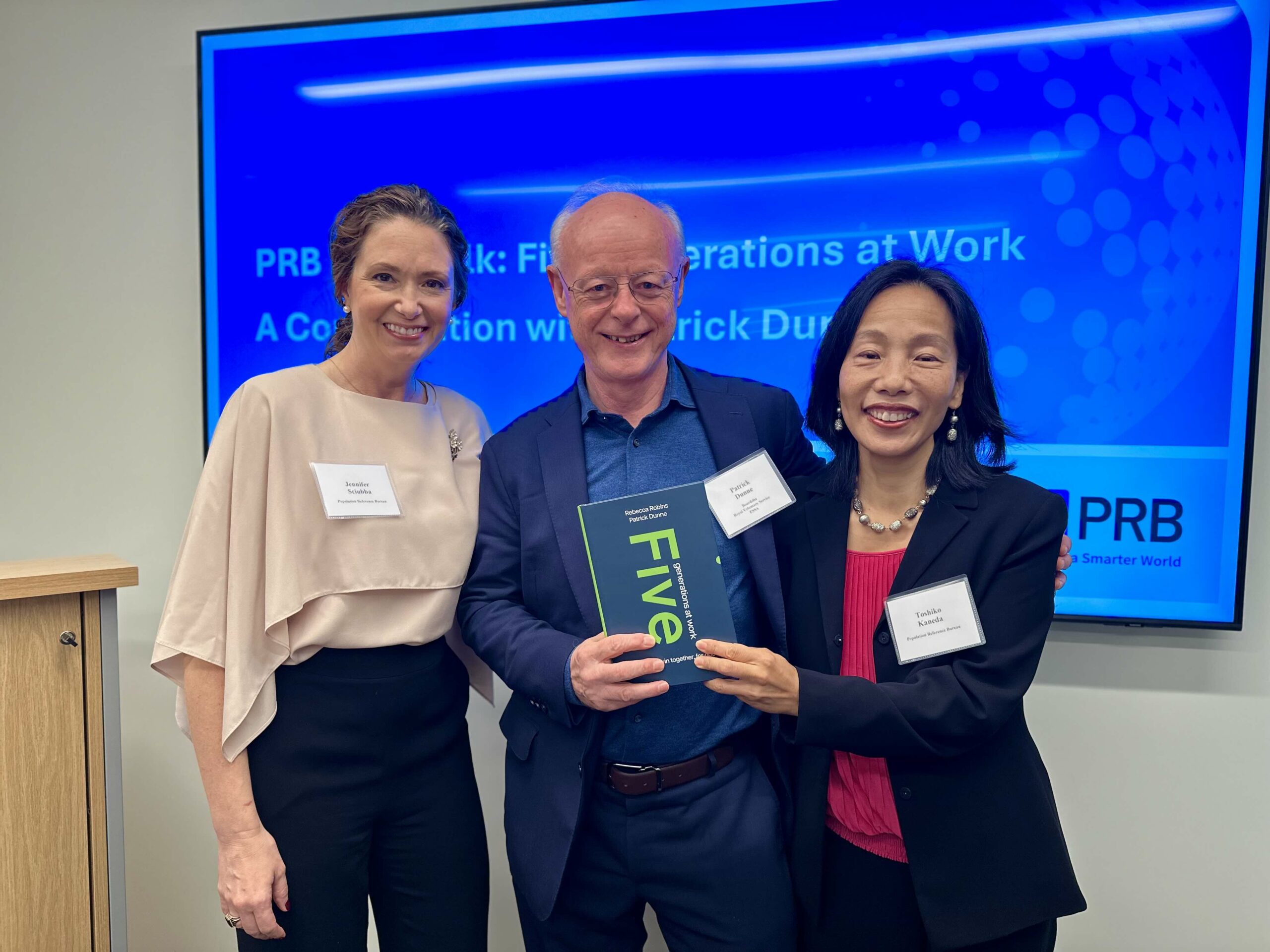Patrick Dunne
Chair, Boardelta, Royal Voluntary Service, and ESSA (Education Sub Saharan Africa)

October 29, 2024

Chair, Boardelta, Royal Voluntary Service, and ESSA (Education Sub Saharan Africa)
Former Director, Communications and Marketing
In the book Five Generations at Work: How We Win Together, for Good, authors Patrick Dunne and Rebecca Robins describe how we’re living in a time of unprecedented demographic change, where five generations work alongside each other in an ideologically and politically fractured environment. And they explore answers to the question, Are generations in the labor market today learning from each other and working together effectively? After a special Book Talk event at PRB’s Washington, DC office, we sat down with Patrick Dunne to explore the ideas in the book and how things are playing out in the real world.

PRB: Why did you and Rebecca Robins write this book, and why now?
Dunne: Two connected triggers prompted this book. The first: a frustration with the prevailing discourse on intergenerational working, which we considered divisive and reductive and getting in the way of seizing a big opportunity. The second was that opportunity: Maximising the benefit of having five generations in the workforce and making the most of the characteristics that each generation brings to work. To achieve this requires a mindset shift, and we felt that by shining a light on so many positive things that relatable organisations of all types were doing across the world, we might spark that shift.
We also felt that this was an urgent issue if we are to solve the greatest challenges facing the world, as well as have a better day at work! The early response has been very encouraging.
PRB: In your book—and at times in PRB’s work too—we refer to populations in certain age groups by generation—Baby Boomers, Millennials, etc.. Widespread public acceptance of these labels helps us easily communicate complicated analyses, but it’s not without controversy. We’ve both used these labels loosely to frame larger discussions, and I’m going to do that now: We know that younger generations in many countries are more diverse than older generations. How does that play into workplace dynamics?
Dunne: There are many variables contributing to diversity within generations, including place, gender, and social diversity. For example, the 9X generation in Vietnam (who came to adulthood after the war and as the economy opened up) or the Born Free generation in South Africa (who came to adulthood after apartheid) think through quite different lenses to those of similar age in other regions. On gender, evidence does seem to be emerging that in some countries, including the United States, there are significant differences in Millennial and Gen Z preferences for many things, including ways of working, with women having a higher preference for working from home than men and—very topically of course—political views, where women are tending to be more left leaning and men more to the right.
Our view is that whilst people find labels convenient, thinking about lenses is much more helpful, especially when trying to understand how and why people see the world differently.
PRB: You identify four factors shaping generational mindset and behavior: 1) economic, 2) social and cultural, 3) technological, and 4) conflict. Post-COVID, these factors all seem to be in play as workplaces struggle to find a new normal. We have companies like Amazon recalling everyone to the office and others like Spotify rolling out “work from anywhere” policies. What do you think are the pros and cons of virtual work with a multigenerational workforce?
Dunne: The debate around working from home or in the office is a classic symptom of all three of the challenges we identify in intergenerational working—“Understanding each other,” “Communicating with each other,” and, most important of all, having a “Maximising Mindset.” A lot of the tension in this debate has not been driven by robust analysis of what might be best for the business or maximising the potential of all resources or understanding different needs. It is often driven by leaders’ or groups of workers’ own preferences and communicated in a less-than-ideal way.
Smart organisations are figuring out how, with a range of preferences amongst the workforce, to achieve the right balance of physical and virtual settings in the best way. It’s worth noting Mick Jagger’s advice, “You can’t always get what you want, but you just might get what you need”—and many of us may need to compromise to get the best overall outcomes.
PRB: You mention that Education Sub Saharan Africa (ESSA) notes post-secondary education in many African countries is under-resourced, yet these countries are home to large, youthful populations. Researchers are wondering if job creation will keep pace as these populations age. Thinking of the work you do with PRB and others in the consortium on Demographics of African Faculty (DAF) in the East African Community, how do your book’s findings connect to the project and its aims to address the massive shortage of faculty across higher education institutions in the region?
Dunne: The work that ESSA has done with governments, PRB, and other partners shows clearly that there is a major shortage (up to 50%) of faculty in African universities and colleges for the current level of students. Given the population pyramids that PRB helped us with and that we have shared in the book, the fact that faculty can’t be microwaved, that participation rates are rising and that there are another 1 billion Africans arriving soon, this shortage is an urgent problem.
Some feel that technology will rescue the day but not—brilliant though it may be if it is “Youtube learning”—on its own. Evidence suggests that blended learning is the most effective model. However, sadly, many current faculty have not been developed and equipped to teach in this way. Gender is another factor. The very low numbers of women doing PhDs across the continent is a major inhibitor to having more female faculty. We need to be innovative to solve this crisis and involve all generations within and outside Africa to not only fix it but stimulate change globally in higher education. There’s a chance for Africa to lead, as it has done in other areas through leapfrogging, such as with mobile payments.
Job creation is not only about the demand and supply in terms of numbers, it is also about the match between the skills and characteristics of those looking for jobs and those needing them. We believe the shortage of faculty across Africa is an inhibitor to both and a literal generational opportunity may be missed if urgent and significant action isn’t taken very soon.
PRB: You discuss numerous examples of multigenerational groups across a range of sectors driving innovation through new approaches to intergenerational working. What are your favorite examples and why do you think they have been successful?
Dunne: It really is tough to choose as there were so many inspiring examples. So I’ll pick one from business and one from government.
The DARE programme from giant luxury goods business LVMH has powered huge innovation across the group and involved over 30,000 employees. DARE stands for Dare, Act, and Risk to Be an Entrepreneur. It was the brainchild of Latitia Roche-Grenet, who was contemplating her next career move in the group when she realised that the 75 “Maisons,” or major business units, weren’t making the most of innovative ideas in different parts of the group. Scale was becoming an inhibitor. So instead of looking for a job that fit her, she created one and, with the support of her boss, created DARE to provide a platform for anyone with a good idea to engage across the group and enlist supporters who could turn those ideas into successful commercial realities. This has fuelled an innovative culture and over 50 new successful business innovations.
The government example is from one of the smallest countries in the world, Wales. Wales has a relatively new devolved government, founded in 1999. In 2016 they created a Future Generations Act, which was linked to the Sustainable Development Goals, and the post of Future Generations Commissioner so that all decisions took into account the potential benefit and impact for future generations.
PRB: You talk about the value of Nextgen boards. Why do you think they’re so powerful? How do you make them work in practice?
Dunne: Nextgen boards come in many forms, and we identified over 200 in our research across a very broad range of organisations. The descriptor has been most used to describe an advisory board of people younger than the main board and drawn from the next generation of leadership, but it also applies to multigenerational groups focused on the next generation of the organisation itself.
The main contributions people look for from their Nextgen boards are fresh insights and innovation, challenges to the board and executive team’s thinking, a mechanism to engage a broader leadership group, and a reinforcement of legitimacy and credibility with younger audiences. We cite examples in the book including the Financial Times, Gucci, and Storo Enso from the corporate sector, as well as Imaginable Futures and the EY Foundation from the social sector, to illustrate the power and transformational potential of Nextgen boards when the main board and executive are clear about what they want from them and provide the support to enable Nextgen boards to flourish.
Nextgen boards are not without their challenges. We discuss some of those, from the basics of setting them up to what they should focus on and leave as a legacy.
PRB: You end the book by talking about the need to shift to long-term thinking, something our political structures (with their focus on the next election) and cultural preferences (intent on the next hot thing) discourage. How can we foster this kind of change in our own workplaces? What can an individual do to overcome these structures?
Dunne: This is probably one of the toughest nuts to crack. Collaborative leadership and the Maximising Mindset I talked about earlier are two key enablers of that shift.
Jennifer Sciubba, PRB’s CEO, summed up a fundamental point on this at the launch event in PRB’s Washington DC office by saying that “This is not a zero-sum game. We have to think bigger than that.” I would add that we also need a shift from “Budget” to “Return on investment” mindsets to help broaden the timespan of consideration. The greatest leaders seem to be able to combine big vision and a long-term view with highly pragmatic, step-by-step approaches, and bringing their populations or organisations along with them. Even if it might not be that obvious at the start.
Patrick Dunne OBE is an experienced Chair, serial social entrepreneur, author of the award-winning book Boards, and a leading expert and advisor on boards and governance. He is Chair of board consultancy Boardelta and the charities Royal Voluntary Service and ESSA-Education Sub Saharan Africa, a Visiting Professor at Cranfield University (England), and an Associate Fellow at Warwick Business School at the University of Warwick (England). He is a long-time PRB partner on the Demographics of African Faculty project.
